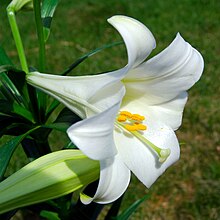Lilium longiflorum
| Lilium longiflorum | |
|---|---|
 |
|
| Scientific classification | |
| Kingdom: | Plantae |
| (unranked): | Angiosperms |
| (unranked): | Monocots |
| Order: | Liliales |
| Family: | Liliaceae |
| Genus: | Lilium |
| Species: | L. longiflorum |
| Binomial name | |
|
Lilium longiflorum Thunb. |
|
Lilium longiflorum (Japanese: テッポウユリ, Teppōyuri), often called the Easter lily, is a plant endemic to the Ryukyu Islands (Japan). Lilium formosana, a closely related species from Taiwan, has been treated as a variety of Easter lily in the past. It is a stem rooting lily, growing up to 1 m (3 ft 3 in) high. It bears a number of trumpet shaped, white, fragrant, and outward facing flowers.
Plants tend to grow from about 50 cm (20 in) to 1 m (3 ft 3 in) tall. They have long oval leaves and the vein enters the horizontal direction. From April to June, the plant's flowering season, it produces pure white flowers on top of the stem. The stem has a cylindrical shape, with a diameter of about 5 cm (2.0 in).
A variety of it, L. longiflorum var. eximium, native to the Ryukyu Islands, is taller and more vigorous. It is extensively cultivated for cut flowers. It has irregular blooming periods in nature, and this is exploited in cultivation, allowing it to be forced for flowering at particular periods, such as Easter. However, it can be induced to flower over a much wider period. This variety is sometimes called the Bermuda lily because it has been much cultivated in Bermuda.
One hundred percent of all Easter lily bulbs used in the United States and Canada are grown on coastal bottom lands in northwestern California and southwestern Oregon. Production of Easter lily bulbs has been controversial because pesticides used to grow the lilies are polluting streams that feed the estuary of the Smith River, California's healthiest and most important river for salmon and steelhead. In 2013 the California North Coast Regional Water Quality Control Board found "acute (and) chronic reproductive toxicity" in three of the four primary creeks that feed the Smith River estuary. One local group, Siskiyou Land Conservancy, has been working since 2004 to reduce pesticide use in the lower Smith River. Research by Siskiyou Land Conservancy found that Easter lily growers use 300,000 pounds annually of highly toxic pesticides. Two of these pesticides — metam sodium and 1,3-dichloropropene, both carcinogens and both deadly to aquatic species — are used in pounds-per-acre amounts that rival any other region of California. A Health Assessment conducted by Siskiyou Land Conservancy found that these pesticides are sickening local residents.
...
Wikipedia
